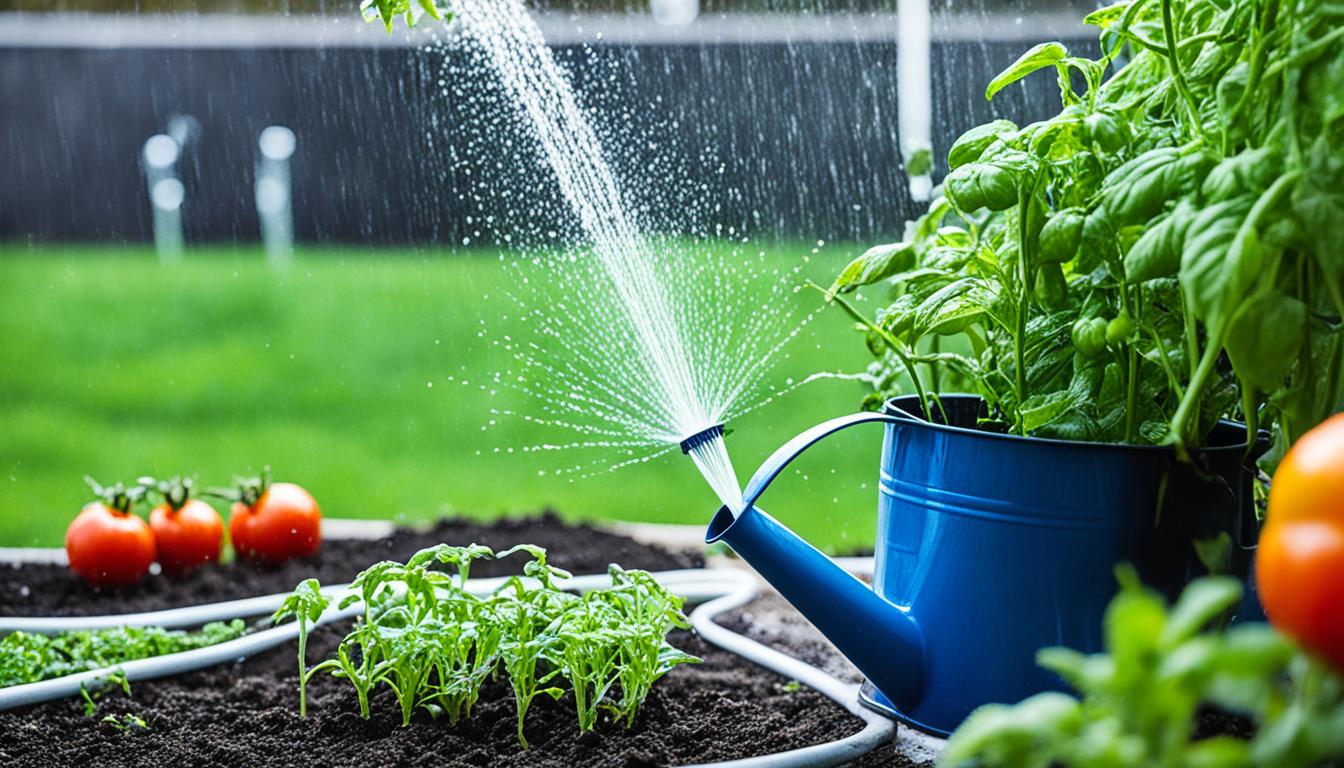Watering is key for growing tomatoes successfully. It doesn’t matter if you’re experienced or just starting. Knowing how to water well can boost your plants’ health and productivity by a lot. This article will explain the best ways to water tomatoes. It covers everything from planting seeds to when they bear fruit. We’ll also look at how to water in pots, raised beds, or in a regular garden to make sure your tomatoes get just the right amount.
Key Takeaways
- Understand the importance of proper watering for healthy and productive tomato plants
- Explore effective watering techniques for different growth stages and growing setups
- Learn to recognize the signs of over- and underwatering to maintain optimal soil moisture levels
- Discover the best watering tools and methods for efficient and targeted watering
- Implement strategies to conserve water and maintain consistent soil moisture for your tomatoes
Understanding Tomato Water Needs
Your tomato plants need water based on where you live, how rainy it is, your soil type, and plant’s growth stage. In dry places, you’ll need to water tomatoes often. But in wet spots, maybe not as much. After a good rain, your plants might be okay for a while.
Climate and Rainfall Considerations
The best soil for your tomatoes is rich and drains well. If your soil is compacted, you may have to change it to help the water flow better.
Soil Type and Drainage
Young tomato plants need more water than older ones. Make sure seedlings always have moisture. But, once they’re grown, they can handle a little drought.
Growth Stages and Watering Requirements
In hot climates, potted tomatoes might need a gallon of water daily. For plants in the ground, water for 20-30 minutes a few times each week. When they bear fruit, potted tomatoes might need water every day at this time. For the first week after planting, water garden tomatoes daily. Then cut back slowly.
Not enough water can make tomato plants wilt and not grow right. Water them well but slowly. Always water in the morning at the plant base. Too much water can also hurt the roots. Find the right balance to keep your plants healthy. Mulch is great for saving water and keeping the soil just right.
Drip irrigation is a top method to water tomatoes. It puts water only where it’s needed. Sprinklers are not the best. They can cause health problems for the plants and waste water. Your tomatoes should get 1-2 inches of water each week. Watch the weather to know how much they need.
Water your seedlings deep to help their roots grow strong. Keep watering them the same way as they grow. Plant gourmets like Tempting Tomatoes® ‘Garden Gem,’ ‘Garden Treasure,’ and Goodhearted® stay healthy against diseases.
If tomato leaves look droopy and the soil is dry, they need more water. Yellow leaves or mushy roots mean they’re getting too much. Adjust as needed. Being aware of your plants’ water needs is key. This way, your tomatoes will grow well and taste great.
When planting tomatoes, give them water a couple times a week. Once they start to bear fruit, they may need daily water in pots. Garden tomatoes can be watered deeply once a week. Raised beds need weekly water to stay moist. With pots, water more often because they dry out quicker in the sun.
Use straw or leaves to keep potted tomatoes moist. Terra cotta pots dry out faster than plastic or metal ones. Containers that water from the bottom cut work in half. Stressed by growth, straw bale tomatoes need regular watering for health.
Deep watering helps tomato roots grow strong. A can is a simple way to water a few plants. A hose keeps the leaves dry. Use soaker hoses or a drip system for easy, efficient watering.
Signs Your Tomato Plants Need Water
Knowing when your tomato plants are thirsty is crucial. If you see leaves wilting and stems drooping, they probably need more water. Without enough water, tomato leaves droop fast and stems can’t support the fruit, often breaking.
Wilting leaves and weak stems point to a thirsty plant.
Wilting Leaves and Weak Stems
Another sign your tomato plants need water is yellow leaves. They might yellow unevenly, showing they lack chlorophyll from not enough water. In these conditions, plants might not bloom or their flowers might fall off early. Both of these situations hurt the plant’s fruit-making abilities a lot.
Yellowing Leaves and Lack of Flowering
If your tomato plants are thirsty, their growth might slow down a lot. They won’t get new leaves, longer stems, or more flowers. All these can mean a plant that’s not getting enough water. Also, their leaves might start to curl to keep more water in, showing they’re in a water-stress situation.
Curling leaves and slow growth are clear signs that plants need more water.
Stunted Growth and Curling Leaves
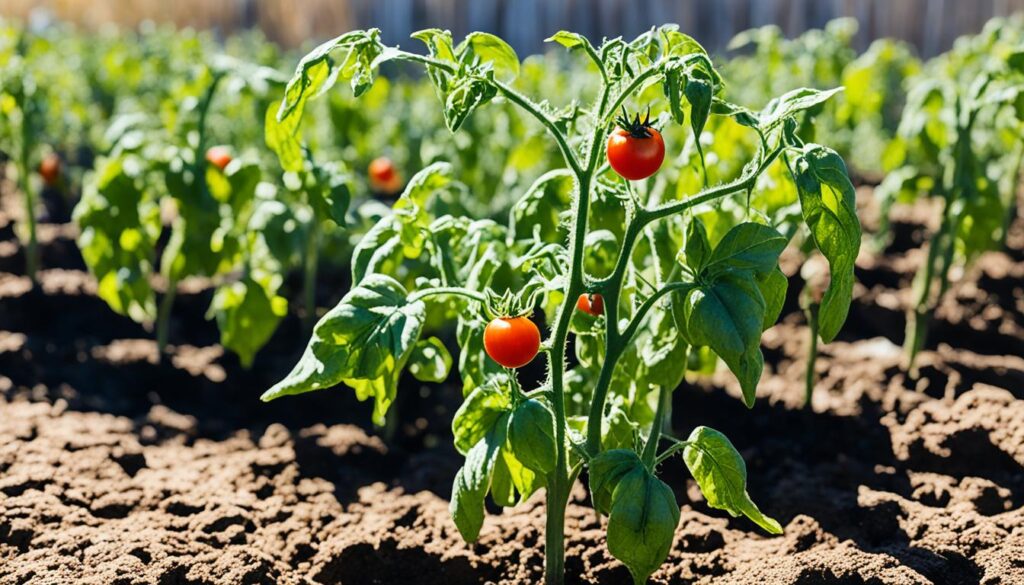
Watering Techniques for Different Growing Setups
The way you water your tomatoes changes as they grow. Baby tomato plants need light watering. You can do this once a day or every other day, depending on where you live. The soil should be moist but not soaked. Too much water is as bad as too little.
Watering Tomato Seedlings
Young tomato plants are best watered with a gentle spray. About 4-5 sprays from a spray bottle is good. This keeps their roots strong and healthy.
Watering New Transplants
New tomato plants, even if they’re in pots or the ground, need daily water. You should water them so the soil gets moist up to 8 inches deep. This is key to helping the plants take root well.
Watering Established Plants
As tomatoes grow bigger, you’ll water them more or less based on the weather. Reduce water when the fruit starts to ripen. This prevents problems like cracked fruit. The amount of water changes as the plants get bigger.
Watering During Fruiting Stage
When tomatoes are getting ready to eat, they need consistent water. The fruit can split if they aren’t watered evenly. More water is needed as they start to bear fruit. For plants in pots, water daily. For those in the garden, water deeply once a week. This keeps the tomatoes healthy and whole.
Watering Potted Tomatoes
Watering tomatoes in pots needs your regular attention. You must keep the soil moist but not too wet. In hot or dry weather, you might have to water them daily or even twice a day. Older tomato plants in pots could drink up to a gallon of water each day. This is very true when it’s hot and dry outside. It’s very important to check the soil often and change how you water based on what you find. This is key for keeping your potted tomatoes healthy.
The kind of pot and the soil you use also affect how much water your tomatoes need. For example, pots made of terracotta or fabric dry out quickly. So you’ll need to water them more. Putting compost or other organic stuff in your soil mix can help it hold onto moisture. This means you might not have to water every day. With special pots that water from the bottom, you can water less often and still keep your tomatoes happy.
It’s important to water deeply, no matter the pot type, for the best tomato growth. Deep watering helps the roots grow down. This makes the plants tougher against dry spells. They can also find and use the water in the soil better.
| Watering Technique | Benefits |
|---|---|
| Watering Can | Allows for precise, targeted watering in small gardens |
| Hose with Watering Wand | Provides more control for larger container gardens |
| Soaker Hose | Delivers water directly to the root zone, minimizing foliage wetting |
| Drip Irrigation | Direct water right where plants need it for the best growth |
If you understand your tomatoes’ unique needs and use the right water methods, you’ll watch your plants do well. Then you’ll be rewarded with lots of yummy tomatoes.
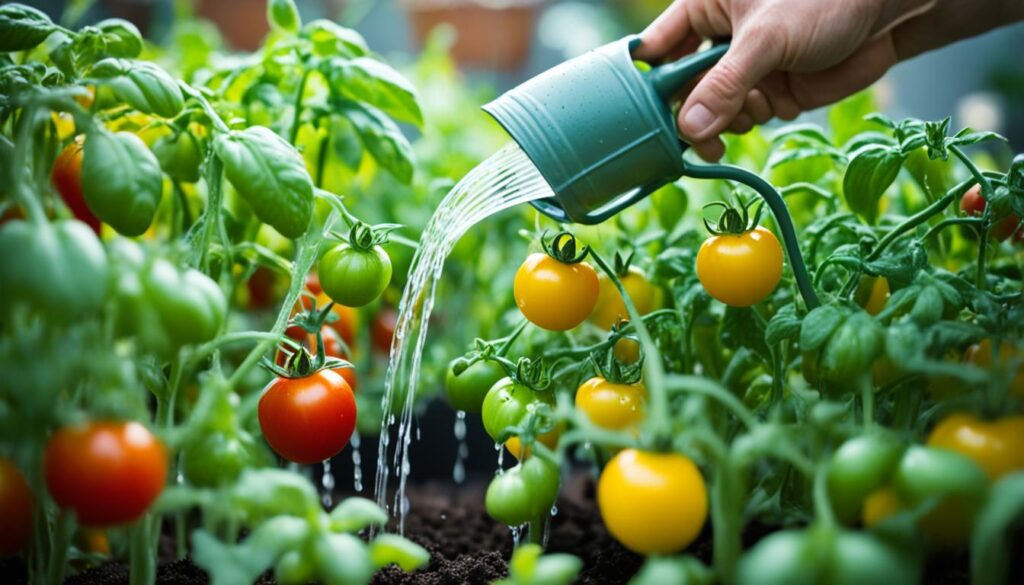
Watering Tomatoes in Raised Beds
Watering tomatoes in raised beds is not the same as in regular gardens. They need weekly watering in summer, but this may change with weather. To keep the soil moist, water for 20-30 minutes, three to four times weekly. For shallow beds, check the soil every day to avoid dehydration.
Using Soaker Hoses
Soaker hoses with timers are perfect for watering tomato plants in raised beds. They let water out slowly and directly, which means less waste and no wet leaves. This method keeps the soil at the right moisture level for healthy tomato growth and great harvests.
Watering Tomatoes in Garden Beds
Tomato plants in traditional garden beds need different amounts of water as they grow.
In the first week or 10 days after you plant them, make sure to water them every day.
After that, water them only three to four times a week once their roots are solid.
Use a soaker hose for watering. This should take 30 minutes to two hours, depending on the weather and the type of soil.
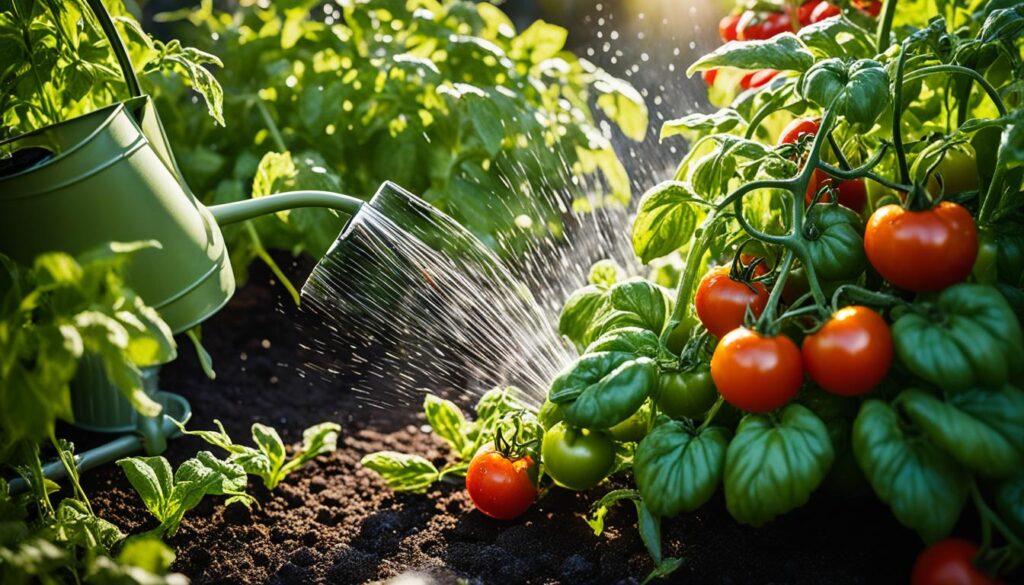
Tools for efficient watering of tomatoes
A watering can is key for keeping your tomato plants healthy. Go for a can with a rose spout for small gardens. It helps water the plant’s base without harming leaves.
Watering Can
For tight spaces, choose a can with a rose spout. It’s perfect for being precise with water, getting the base of your plants wet. This way, you keep the soil’s structure intact and avoid disease from moist leaves.
Hose with Watering Wand
In larger gardens, a watering wand helps. It connects to your hose and lets you water deep at the plant’s base. This method needs more of your time, but it’s a good opportunity to see how each plant is doing as you water.
Soaker Hose
Soaker hoses are great for big tomato gardens. They slowly let out water, which goes straight to the soil and roots. This way, you save water and make sure all plants get evenly watered.
Drip Irrigation Systems
The best way to water tomatoes is with drip irrigation. It puts water right at the plant’s base. This system makes sure all plants get the same amount of water and helps you save water. It’s a bit of work to set up, but it’s worth it, especially if you use a timer with it.
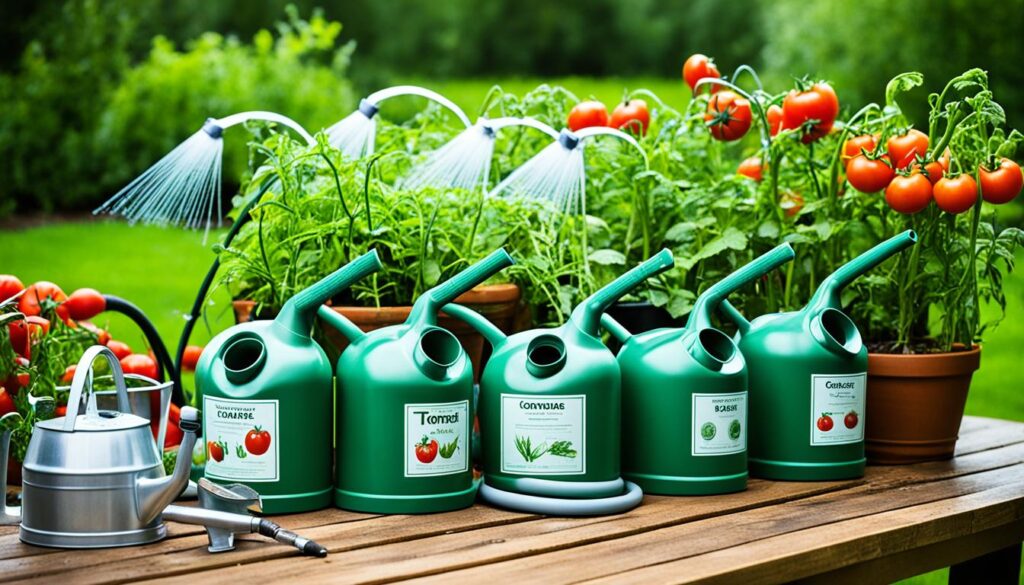
Effective Watering Tips
When you water your tomatoes, do it slowly and deeply. This helps the roots grow down to find water. It makes your plants stronger. Make sure the water soaks into the ground 6-8 inches deep.
Deep and Slow Watering
Drip irrigation is a top way to water tomatoes. It sends water right to the roots. For better results, use a watering can with a rose spout. It spreads water into small streams smoothly. Soaker hoses are great too. They water all plants evenly as water trickles from the hose.
Morning Watering
Water your tomato plants in the morning. It keeps the soil moist during hot days and reduces water loss. This also cuts the chance of getting diseases because the leaves can dry before dark.
Watering at the Plant’s Base
When you water, aim at the soil by the plant’s base, not the leaves. Watering from above can cause diseases and attract pests. Direct the water straight to the roots. It’s where your plants really need it.
Common Watering Mistakes to Avoid
Watering your tomato plants is tricky. Too much water can hurt the roots and cause disease. Yet, too little water makes the plants stressed. It’s key to check the soil before you water. Aim for deep, less-frequent watering to help roots grow strong.
Overwatering and Underwatering
Be smart about how you water. Watering directly at the plants’ base is best, not on the leaves. Damp leaves can get sick or damaged by the sun. Try using a soaker hose or drip system for better results.
Improper Watering Technique
Tomato plants need different amounts of water. It helps to group plants with the same needs together. Also, learn about what each type of tomato likes. Some tomatoes like lots of water, others prefer dry soil. Knowing your plants’ water needs is key to keeping them healthy.
Ignoring Plant Needs
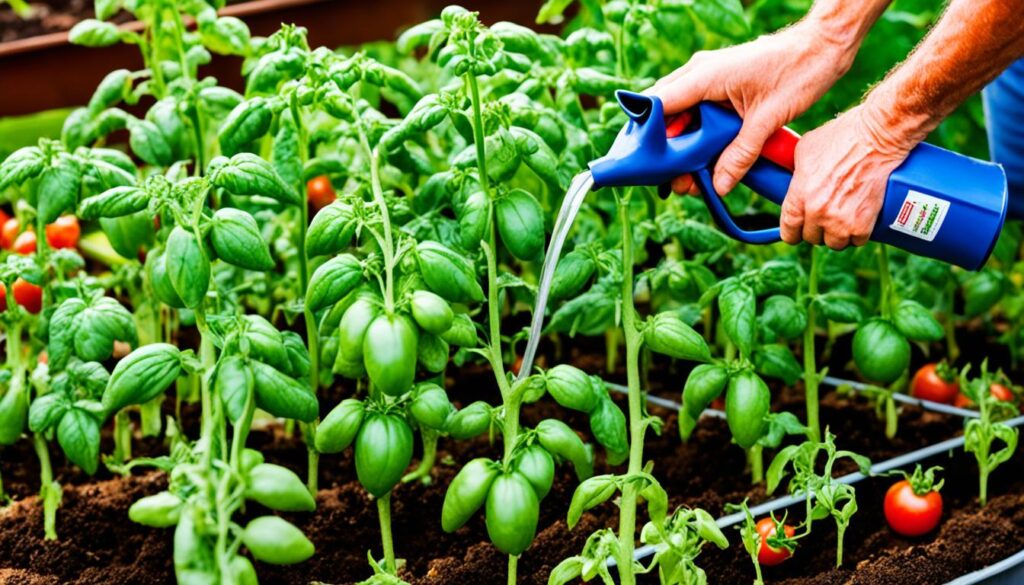
Mulching and Drainage Considerations
Mulching keeps soil moist for your tomato plants. It holds moisture in and stops it from evaporating. This lowers the risk of oversaturated ground, which can cause diseases and rot.
Good drainage is key. It stops the soil from becoming waterlogged. Your tomato plants will be healthier this way.
| Benefit | Description |
|---|---|
| Mulching | It keeps soil moist, stops water from escaping, and can make soil better. This is great for tomato plants. |
| Drainage | Keeping water moving is vital to avoid too much wetness. Overly wet soil harms tomato plants. |
Use mulching and right drainage for top tomato growth. This ensures they grow well and give you plenty to harvest.
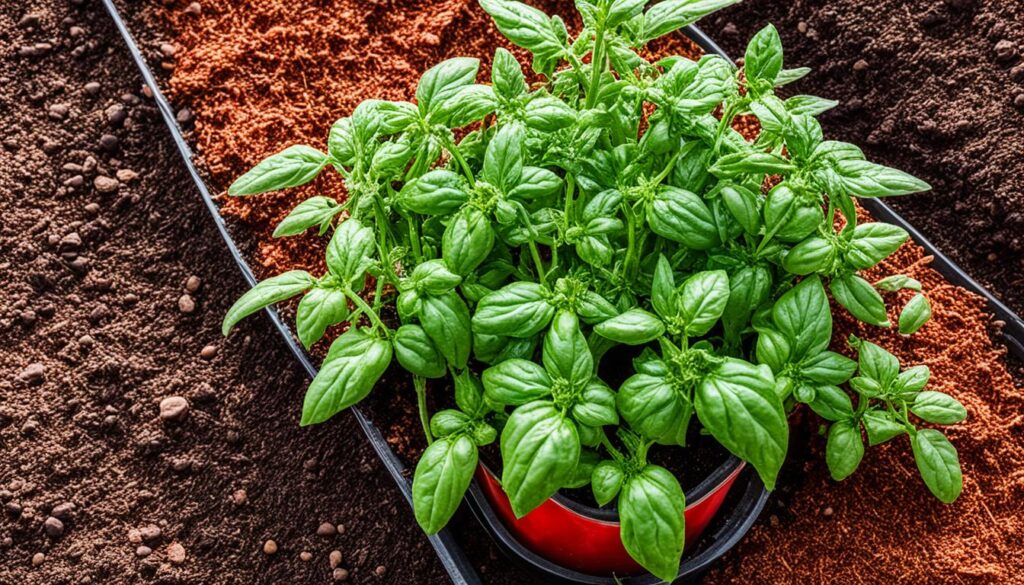
Conclusion
Getting water just right is key for tomato plants to flourish. Learn what they need and how to tell if they’re over or under watered. Use the best watering methods and tools to help your tomatoes grow big and tasty.
This guide will help you become a tomato watering expert. Your garden will be set for a great growing season.
A new drip system can boost tomato harvests by 50%. It also makes water use 54% more efficient. Using less water and effort, you can get more tomatoes. This leads to a better season of growth.
It’s important to keep water draining well. Change how often you water based on your area and the weather. With right watering skills and tools, challenges can be managed. You’ll have plenty of tomatoes, no matter your location or climate.
FAQ
What factors influence the watering needs of tomato plants?
Tomato plants’ thirst changes based on where they are and how old they are. Weather, how much it rains, soil, and the plant’s growth stage matter.
How do I know if my tomato plants are getting enough water?
Look out for these signs if you think your tomatoes might be thirsty: wilting, weak stems, yellow leaves, not flowering, not growing well, and curling leaves.
How do I water tomato plants in different growing setups?
Watering is different for each stage of the tomato’s life. For those with fruits, keep the water coming often and steady.
How do I water tomato plants in pots?
Tomatoes in pots need a lot of water and attention. In very hot and dry weather, they might need a drink once or even twice each day.
How do I water tomato plants in raised beds?
With raised beds, water for a good 20-30 minutes, three to four days a week. It can help a lot to use soaker hoses on a timer.
How do I water tomato plants in traditional garden beds?
In garden beds, first water every day for a week or 10 days after planting, then lessen it to three to four times weekly. Use a soaker hose for the best results.
What are the best tools for efficient watering of tomatoes?
To make watering easier, try using the right tools like watering cans, hoses with wands, soaker hoses, and drip systems.
What are some effective watering tips for tomato plants?
The best tips are to water deeply and slowly, do it in the morning, and water at the plant’s base to keep its leaves dry.
What common watering mistakes should I avoid for tomato plants?
Don’t over or under-water your tomatoes, and make sure you’re doing it right. Knowing what your plants need is also crucial.
How do mulching and drainage impact tomato watering?
Mulching helps the soil hold onto water and slows down evaporation. Good drainage stops the water from sitting too long, which can hurt the roots.
Source Links
- https://www.rasnetwork.org/plant-diseases-care/watering-tomato-plants/
- https://www.gardendesign.com/tomato/watering.html
- https://savvygardening.com/how-often-do-you-water-tomato-plants/
- https://jobescompany.com/blog/top-10-tomato-growing-mistakes-how-avoid-them/
- https://www.ncbi.nlm.nih.gov/pmc/articles/PMC4461261/
